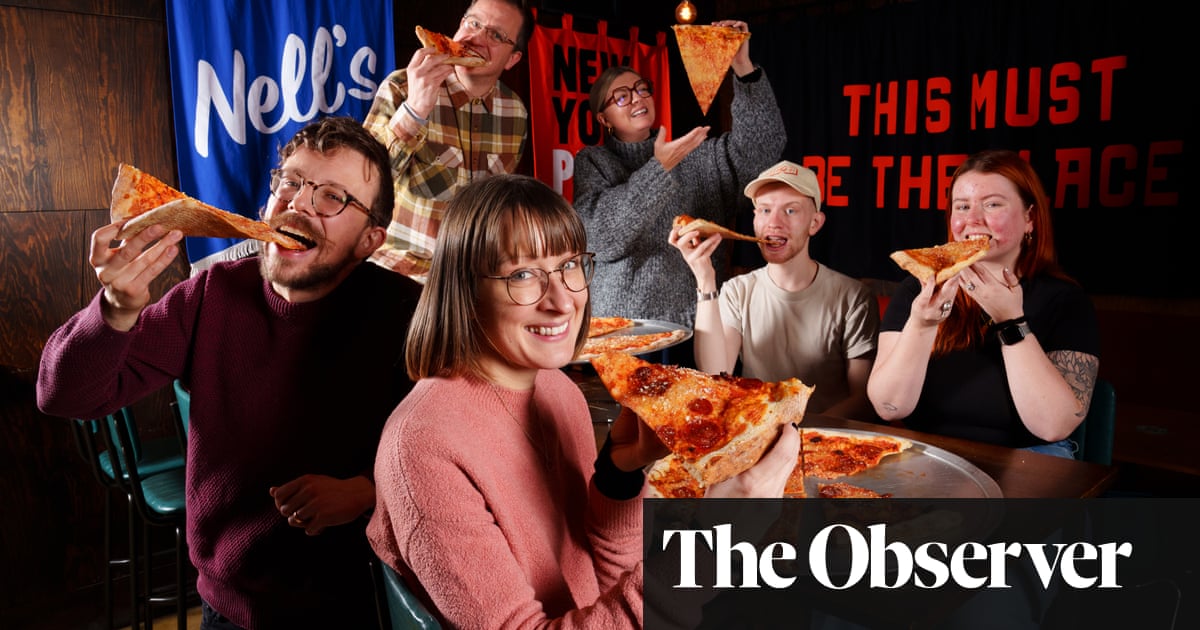
1 The rise and fall of celebrity chefs
By the time OFM launched in April 2001, Gordon, Heston, Hugh, Jamie and others were already on a spectacular trajectory. These were the decades of reality TV so we didn’t just watch them, we took an unshakeable interest in their personal lives. Nobody knew what Delia Smith did when the cameras were off. Keith Floyd never invited us into his beautiful home, but the cooks we now knew by their first names were all over the tabloids and the new gossip magazines. A slightly bewildered Delia Smith expressed it well when, in 2008, she said of Gordon Ramsay: “That’s not teaching. I like him when he does his recipes, but I’m not keen on his swearing.”
You could plot their trajectories on a graph. Ramsay was first, rising highest and burning brightest. He left the UK for the US where he is now one of its wealthiest TV stars and recently returned to UK screens presenting a non-food gameshow. He has done best in financial terms but has somehow detached himself from food despite still owning dozens of restaurants. Other arcs are lower, perhaps longer lasting, but are now on a downward curve. It’s unlikely we’ll ever see their kind again.
2 From bloggers to influencers
In 2002, Julie Powell began the “Julie and Julia Project” where she documented her attempts to cook every recipe in Julia Child’s Mastering the Art of French Cooking via the new Blogger platform. Three years later it had generated a bestselling book and by 2009 a movie starring Meryl Streep and Stanley Tucci.
Another gamechanging platform, Twitter, launched in 2006 and quickly became particularly favoured by food journalists and the restaurant industry. After Instagram arrived four years later, a “grammable” dish became a vital feature on every menu and photos of dinner the currency of hospitality marketing and newly democratised restaurant criticism.
Food media has undergone terrific upheaval. Today, having a large online audience or being an “influencer” is an indicator of celebrity that sits alongside and is increasingly interwoven with being a successful chef, TV star or restaurateur. Traditional fame clearly has its uses though. One of the biggest food faces on this year’s most powerful social platform, TikTok, is Gordon Ramsay.
3 Noma, foraging and the new Nordic
Culinary maverick René Redzepi opened Noma in Copenhagen in 2003. Though it never achieved three Michelin stars, in 2010 it was declared the best restaurant in the world– seen by many as a first and significant crack in the Michelin hegemony. Redzepi’s cooking was regarded as the vanguard of “new Nordic”, focusing on traditional regional ingredients and flavour combinations, espousing “molecular” technique with a lighter hand. Redzepi also led chefs, more than metaphorically, “into the woods”. His fascination with foraging began a worldwide trend for obscure ingredients without the intervening hand of human agriculture.
4 MasterChef and food as light entertainment
John Torode and Gregg Wallace were introduced to MasterChef in 2005 to make the programme more accessible and less stuffy, their breathless presentation helping to up the excitement and jeopardy, creating a phenomenon. Other competitive food shows followed with Great British Menu launching in 2006 and in 2008 MasterChef: the Professionals, both popular showcases for working chefs.
These programmes required a particular style of cooking that could be discussed at length and had an element of risk. Soon they had codified and ossified provincial British gastronomy, locking us into a never-ending parade of piled food, smears and local ingredients showcased “three ways”.
5 The new informality
In 20 years eating out has, for many of us, changed from a rare treat to a regular event, and perhaps as a result the places we choose have become more informal. Napery, uniformed staff, dress codes and the crusty etiquettes of our parents’ generation have evaporated in a glorious melee of eating with fingers, sitting at counters, no bookings and courses arriving in whatever order suits the kitchen. Generally it’s all been a vast improvement. Perhaps the only downsides have been, for the customer, endless queueing for unbookable seats and, for restaurants, no-shows when customers book several locations at once and commit to one at the last minute.
6 From school dinners to Little Chef: the TV activists
Jamie Oliver’s attempt to improve school dinners in 2005 by booting out Turkey Twizzlers and endless chips met highly publicised resistance from some kids and parents. Nevertheless he kicked off a trend for TV-driven food activism that peaked towards the end of the 00s. There were a few months, when Heston was fixing the food at Little Chef and the ever dependable Hugh Fearnley Whittingstall was fighting about fish or chickens, when it seemed no politician or food producer could avoid being doorstepped by an indignant TV cook. The always ambitious Oliver later tackled education in general, with Jamie’s Dream School in 2011.
7 Booking and delivery
Toptable – launched in 2000 – was the first booking engine in the UK. In 2010 it was bought by US company OpenTable for $55m. To most customers it was just a convenient app, but behind it was a complete bookings management system that restaurants eagerly adopted, handing over responsibility for answering phones and juggling bookings. Apps quickly became the main way that restaurants were booked and today they want to know your location, build a list of your preferences or interests and recommend places to dine in a way that cuts the restaurant out of the loop.
In 2013 Deliveroo was launched in the UK, transforming takeaway and leading to competitors such as Uber Eats, but also to dark kitchens (where food is cooked for delivery only). As takeaway has become such an important part of lockdown life, diners have been able to use Deliveroo to choose food from a brand they recognise, and don’t particularly need their meal to come from the restaurant’s own kitchen. In recent months, Dishoom and Shake Shack have “opened” in provincial towns, delivering to customers without opening an actual “restaurant”. Deliveroo itself has hit problems with the row over gig economy workers’ rights and its poorly received stock market flotation this month.
8 El Bulli closes
The revolutionary Spanish restaurant had earned its third Michelin star under Ferran Adrià in 1989. In 2002, it took the No 1 spot in the brand new World’s 50 Best Restaurants list, a position it held more times than any of its competitors. Adrià himself became the ideal of the chef-as-artist, but the most significant thing about El Bulli in the years concerning us was that it closed.
Adrià claimed it wasn’t making money, losing as much as €500,000 a year towards the end. But as he went on to transform it into a “foundation and creativity centre” it seems equally possible he’d become bored by insanely long waiting lists and the international set jetting in to marvel at his creations. Either way, to quote its own release, El Bulli “completed its journey as a restaurant”.
9 Wine goes Sideways
In 2004, Sideways, an arthouse film set in Napa Valley, achieved modest box-office success but it was the wine industry, or at least the producers of pinot noir, that seemed to benefit most, with a 170% increase in sales in the US. Sideways kicked off a series of rolling, broader-based wine trends. A great great rejection of chardonnay, a sudden fascination with pinot grigio. An inexplicable rioja frenzy, and a lust for malbec. There had been decades when nobody knew what a picpoul de pinet was, then suddenly you had to have one on your list or you’d lose punters. Cava came and went, prosecco has had an unbelievably good run. You might be looking good with grower champagne this week, but it’s impossible to stay ahead. Just drink widely and hang on for the ride.
10 The third waves
The term “third wave” was first used in 2003 to describe the rise of independent speciality coffee shops – the second wave had been big chains such as Starbucks, the first wave had been … well, coffee. Third wave shops encouraged a greater concentration on the skills of the barista and the use of single estate coffees or new brewing techniques.
Third wave could also describe a pattern of appreciation that has occurred throughout the food world in the last couple of decades. A second wave resurgence as the public rediscover a product, then a third wave as food nerds focus on it more deeply. We’re in the middle of third waves of bread, fermentation, natural wines, tea, gin and craft beer.
11 The rise and rise of female chefs
It would be impossible to deny that two decades of macho, sweary, would-be rock star chefs hasn’t sidelined women. At the turn of the century, women were still a rarity in professional kitchens, but 20 years on we are seeing more food businesses owned by women, more female-led kitchens and roles more open to women at all levels.
In some ways, the media explosion around food initially hinged on opening up cookery programmes, once mostly targeted at women, to male audiences by lionising the masculinity of celebrity chefs. As the decades have passed, the stereotype is collapsing under the weight of its own absurdity and a kind of balance may be beginning to emerge. We still have a long way to go before there’s anything like equality, but chefs such as Clare Smyth, Hélenè Darroze, Angela Hartnett, Dominique Crenn, Anne-Sophie Pic and Elena Arzak have won stars for their brilliance, not just for surviving.
12 All recipes are online
Perhaps the biggest change the internet has wrought on food is the simplest. Comprehensive sharing of information has entirely changed the nature of the recipe. Anyone can find out how to cook anything in a couple of clicks. They can get second opinions, enter discussions and contribute their own improvements. The internet has moved beyond recipes into a kind of vast commons of knowledge sharing. In doing so, it’s destroying old hierarchies. Europe is no longer the centre, entrenched techniques can be questioned with ease and hitherto unimaginable combinations can arise.
13 #MeToo in hospitality
The #MeToo movement had already existed for more than a decade when Harvey Weinstein’s crimes brought it into the wider public eye, causing many industries to look at themselves. It would be impossible to assert that over 20 years women had not been hurt and held back by the macho culture in many kitchens. US media published allegations of sexual misconduct involving major figures in food, resulting in the resignations of Mario Batali (2019) and Ken Friedman (2020).
There was self-examination across the UK industry but remarkably few accusations or resignations. Anecdotally, behaviour towards women in the industry is improving, but it’s hard to imagine there aren’t people out there knowing they dodged a bullet.
14 Veganuary and veganism
Veganism has become an increasingly powerful trend over the past decade. In 2019, 14,262 new products were registered as vegan with the Vegan Society, an increase of 49% on the previous year. This is partially due to the environmental movement’s focus on eating less meat, but also because increased regulation has made it difficult to make health claims for food products. Words such as “healthy” and “good for you” can no longer appear on packaging without scientific backup, so the food industry has seized happily on formulae like “promotes wellbeing” or “plant-based” as substitutes.
The most prominent result of the trend has been Veganuary, launched in 2014 by campaigners Jane Land and Matthew Glover. You sign up, declare your commitment to go meat-free for a month and even get a kit to help you stick to it. More people sign up every year – it was nearly 600,000 this time – but the notion spreads to many more.
15 Supper clubs and pop-ups
Perhaps inspired by paladares, the illegal underground restaurants of Cuba, food lovers began “popping up” their own quasi restaurants in the UK. It’s generally accepted the first was Kerstin Rodgers’s Underground Restaurant, based in her flat in North Kensington, but dozens of others soon followed. A successful run of pop-ups was soon seen as a serious route to a restaurant career with chefs such as Asma Khan, James Ramsden and Stevie Parle leading the charge.
16 Street food
By the 1990s, street food was a sector marked by poor hygiene and held in check by aggressive local authority licensing. A trend for outdoor music festivals and events, plus deregulation of the wedding market, created a pool of talented young cooks ready to operate on the move. At the same time, local authorities lightened their attitude to traders, and property developers saw street operations as a way of injecting life and soul into new developments. Perhaps the most gloriously cheeky example is Bob’s Lobster where a couple of street food entrepreneurs literally reversed their successful food truck into vacant premises under the newly developed Shard and continued their business indoors, to critical acclaim.
17 Anthony Bourdain
Bourdain’s scabrous part-memoir Kitchen Confidential, published in 2000, was an inspiration to many of the chefs of the subsequent two decades. Trained in the classical French style, he had practised as a journeyman chef, often propped up by drugs, but with the proceeds of the book he launched into a media career, travelling widely and appreciating that food was a touchpoint for cultural understanding, spoke about context not recipes. He championed young chefs such as Gabrielle Hamilton and April Bloomfield and, during #MeToo, said of his memoir, “I’ve had to ask myself, and I have been for some time, ‘To what extent in that book did I provide validation to meatheads?’”
Bourdain’s death in 2018 shocked the industry and fans alike. He reached an incredibly wide audience, including Barack Obama who appeared in the Hanoi episode of Parts Unknown in 2016.
18 Black Lives Matter
From 2014 Black Lives Matter moved through the public discourse, acquiring the same breakneck pace as #MeToo. In the UK it triggered important questions about the representation of minorities in food media and combined with a longstanding debate around cultural appropriation in food. In the US it resulted in high-profile resignations plus some rewriting of the recipe archive at Epicurious.
In the UK, there has been some change within the media, with attention turning to people of colour in hospitality and attribution of recipes more carefully watched. But with 300,000 people from black, Asian and minority ethnic backgrounds working in the industry, and facing pay gaps relative to white British staff, the jury is still out on measurable change in kitchens, dining rooms and at board meetings.
19 Brexit meets the pandemic
Brexit and Covid hit the food and drink world at roughly the same time. Many had predicted problems with staffing, prices, ingredient prices and importation, but no one could have guessed the entire hospitality industry would have to shutter for almost a year. Eight out of 10 hospitality workers were furloughed at the start of the crisis, according to the Office for National Statistics.
Supermarkets and delivery companies have “had a good pandemic” as we’ve all spent more time eating at home, but workers, particularly in food processing factories, have been among the most at risk. The pubs, clubs, bars, cafes and restaurants that have managed to survive the lockdowns will crawl back into the light severely weakened.
The past two decades have seen the hospitality industry grow at an almost incredible rate, but it relies on socialising. It would be horribly bleak to say that the pandemic marks the end of the food renaissance in the UK, but the truth is it’s the most significant thing to happen to most of us in our collective lifetimes and we still have no idea how it’s going to play out.
20 The Great British Bake Off
The success of Bake Off is staggering. It rates brilliantly across age, gender and social class without a single expletive, flare of fire or flash of knife. It is based around cake – an effective synecdoche for triviality – and the show refuses to make serious attempts to rack up false jeopardy. Aggressive displays of manliness are restricted to a single judge who is, frankly, cuddly.
I have a theory that this is, in fact, its secret. Since 2010, the point when we started to need it, The Great British Bake Off has been the antidote to the more pompous aspects of the recent food renaissance. We now export it worldwide. May God forgive us.











